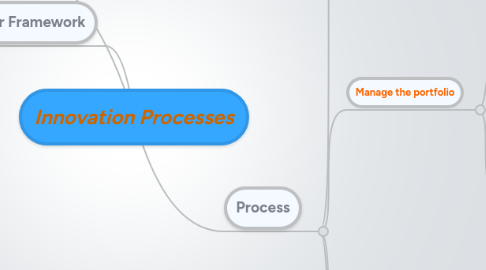
1. Linkages to Other Framework
1.1. Customer Perspectives
1.1.1. offer enhanced product/ service functionality to customer
1.1.2. first-to-market with new product and service
1.1.3. extend products / services to new segments
1.2. Financial
1.2.1. Objectives
1.2.1.1. return on R&D investments
1.2.1.2. revenue growth from existing customer
1.2.1.3. revenue growth from new customer
1.2.1.4. manage life-cycle costs
1.2.2. offer customer a value proposition
1.2.2.1. represent the specific how the performance of the company's product and sen
1.3. Learning and Growth
1.3.1. Human Capital
1.3.2. Information Capital
1.3.3. Organization Capital
1.3.3.1. Organizational Culture
1.3.3.1.1. Not-Invented-Here Syndrome
1.3.3.1.2. Flat organization
1.3.3.2. Teamwork
1.3.3.3. Leader
1.3.3.3.1. Knowledgeable Person
2. Peluang Thesis
2.1. Human Capital to support Innovation, in what kind of organization?
2.2. Konstruk Psikologi yang bisa diukur dalam hal Innovasi
2.2.1. Creativity
2.2.2. Readiness to Change
2.3. Behavioral Sciences
2.3.1. Individu
2.3.1.1. Motivasi
2.3.1.2. Leadership
2.3.2. Group
2.3.2.1. Group Dynamics
3. Process
3.1. Identify the opportunity
3.1.1. objectives
3.1.1.1. anticipate customer needs
3.1.1.1.1. spend time with key customer to learn their future opportunities and needs
3.1.1.1.2. number or percent of new projects launched based on client input
3.1.1.2. discover new opportunities
3.1.1.2.1. number of new projects or concepts presented for development
3.1.1.2.2. number of new value-added services identified
3.1.2. ideas come from many sources
3.1.2.1. Internal resources
3.1.2.2. External resource
3.1.2.2.1. customers
3.1.2.2.2. research laboratories
3.1.2.2.3. universities
3.1.2.2.4. suppliers
3.2. Manage the portfolio
3.2.1. choose and manage mix of project
3.2.1.1. basic research and advance development projects
3.2.1.1.1. create new science and technology knowledge that able to apply in the commercial projects
3.2.1.1.2. often done by separate organization
3.2.1.2. breaktrough development projects
3.2.1.2.1. create entirely new products, based on applying science and technology in a new way
3.2.1.2.2. extend over several years
3.2.1.3. platform development projects
3.2.1.3.1. develop the next generation of products in given category
3.2.1.3.2. to define the basic set of new product
3.2.1.3.3. deliver fundamental improvement in cost, quality and performance over the previous generation of products
3.2.1.4. derivative development projects
3.2.1.4.1. leverage existing product and process capabilities
3.2.1.4.2. to deliver a product to specific market segment
3.2.1.4.3. modification
3.2.1.4.4. require far fewer resources than platform or breakthrough development
3.2.1.5. alliance projects
3.2.1.5.1. enable company to acquire new product from another firm
3.2.1.5.2. when?
3.2.2. objectives
3.2.2.1. actively manage the product / offer portfolio for superior innovation and customer positioning, performance and profitability
3.2.2.1.1. actual vs desired mix of projects
3.2.2.1.2. actual vs desired spending on projects of each type
3.2.2.1.3. technology ranking (independent peer review of current technology capabilty
3.2.2.1.4. net present vaue of products in project pipeline
3.2.2.1.5. reach (customer feedback and revenue projections based on prototypes of products in pipeline
3.2.2.1.6. option value from project portofolio
3.2.2.2. extend product to new application
3.2.2.2.1. number of life-cycle extension projects
3.2.2.2.2. number of projects leveraged from existing platforms that are targeted at new markets
3.2.2.3. collaborate
3.2.2.3.1. number of licensed products
3.2.2.3.2. number of joint projects in new or emerging market
3.2.2.3.3. number of technology or product partner
3.3. Design and Develop
3.3.1. manage products through development stages
3.3.1.1. stages
3.3.1.1.1. concept development
3.3.1.1.2. product planning
3.3.1.1.3. detailed product and process engineering
3.3.2. objectives
3.3.2.1. to bring new concepts to market
3.3.2.1.1. with the desired functionality
3.3.2.1.2. attractive to the targeted market
3.3.2.1.3. can produced with consistent quality
3.3.2.1.4. enabling satisfactory profit margins to be earned
3.3.2.1.5. meets the target for completion time and development cost
3.3.2.2. reduce development cycle time
3.3.2.3. reduce development cost
3.3.3. development process
3.3.3.1. funnel
3.3.3.1.1. wide opening at the beginning, indicates the maximum flexibility for concepts, product design and manufacturing process
3.3.3.2. stage-gate process
3.3.3.2.1. specifically identifies a series of development stages through which a new product must pass
3.3.3.3. waterfall process
3.3.3.3.1. use by software development company in developing their traditional hardware product
3.3.3.3.2. one phase spilled into the next in well-defined
3.3.3.3.3. sequential progression
3.3.3.4. milestone process
3.3.3.4.1. milestone with daily build process
3.3.3.4.2. milestone process
3.4. Launch new product
3.4.1. conclusion of the product development cycle
3.4.1.1. test whether the new or modified manufacturing process can produce the finished product at commercial volume levels that meet functional and quality standards.
3.4.1.2. validates that all suppliers can deliver their materials and components
3.4.1.2.1. specifications
3.4.1.2.2. on time
3.4.1.2.3. at targeted cost
3.4.1.3. company starts commercial production at low volume levels to ensure that its product processes and those of suppliers can consistently produce and deliver product.
3.4.2. objectives
3.4.2.1. ramp-up time
3.4.2.2. production cost, quality, cycle time
3.4.2.3. achieve initial sales goals
